В.Кондратьев Самолеты первой мировой войны
Моран-Солнье" N/I/V ("Моран-монокок") / Morane-Saulnier N/I/V (Morane Monocoque)
Самолет разработан братьями Моран и Раймондом Солнье в начале 1914 года как спортивная скоростная машина для участия в воздушных гонках. Первый полет под управлением Ролана Гарро состоялся 21 января. Конструкция цельнодеревянная, обшивка - полотно, двигатель - "Рон", 80 л.с. Слово "монокок" в названии машины тогда означало не фюзеляж с работающей обшивкой, а фюзеляж круглого или овального сечения.
Самолет, показавший высокие скоростные данные, был признан гораздо лучшим кандидатом на роль истребителя, чем тихоходный двухместный "Моран-парасоль". В апреле 1915-го на несколько "монококов" поставили курсовые пулеметы "Гочкис" и винты с отсекателями пуль, аналогичные тем, что Гарро месяцем ранее установил на своем "парасоле". Иногда эти машины называли "Моран-Солнье Nm", где буква "m" означает "милитэр", то есть "военный". Машина выпускалась серийно с мая 1915 по июнь 1916 года в трех модификациях.
На "монококах" летали французские, английские и российские пилоты. Первыми их получили французы, затем - англичане, а в Россию эти машины прибыли довольно поздно - в ноябре-декабре 1916-го, когда на Западе они уже считались морально устаревшими и были сняты с вооружения фронтовых частей первой линии.
"Моран-монокок" не пользовался популярностью у английских и французских пилотов, так как он был весьма строг в управлении и имел тенденцию к срыву в штопор из-за слишком задней центровки. Французы отказались него еще в мае 1916 года, отдав предпочтение полуторапланам "Ньюпор", англичане провоевали на "моранах" до октября. На русско-германском фронте "монококи" применялись примерно до осени 1917-го, при этом российские пилоты на сложности пилотирования не жаловались. В тогдашних российских документах эту машину, как правило, именовали сокращенно - "мормон".
МОДИФИКАЦИИ
"Моран-Солнье N" (Nm) - двигатель "Рон", 80 л.с. Вооружение - курсовой пулемет "Гочкис" без синхронизатора. Построено 49 экземпляров для французских ВВС (из которых на фронт попала примерно половина, остальные использовались в летных школах) и 24 - для английских. Англичане перевооружили свои "монококи" пулеметами "Льюис".
"Моран-Солнье I" - двигатель "Рон", 110 л.с. Вооружение - синхронный пулемет "Виккерс". Слегка увеличен размах крыла. Весной 1916 года построено четыре экземпляра для британских ВВС и осенью того же года - еще 20 - по российскому заказу (согласно иным данным - 50). Еще один самолет в 1916 году построен в опытном порядке на московском заводе "Дукс". От французских "моранов" он отличался отсутствием вооружения и кока винта.
"Моран-Солнье V". Самолет с тем же двигателем и вооружением, что и у предыдущей модификации, но с повышенной дальностью полета за счет установки в носовой части фюзеляжа дополнительного бензобака и еще раз увеличенным размахом и площадью крыла. Построено 12 экземпляров для британских ВВС.
А.Шепс Самолеты Первой мировой войны. Страны Антанты
Моран-Сольнье тип N 1915 г.
Машина стала дальнейшим развитием самолетов типа M. Но с целью получения максимальных скоростных и маневренных качеств, фирма пошла на значительное уменьшение размеров самолета при том же двигателе. Машина была короче прообраза на 1,2 м. Размах крыльев уменьшен на 1,7 м, а площадь - почти в 1,5 раза. Однако прирост скорости был достигнут незначительный, а вот из-за высокой нагрузки на крыло маневренные качества - и особенно взлетно-посадочные - ухудшились. Машина была строгой в управлении. Поступившие в боевые эскадрильи машины быстро заменялись более современными самолетами фирм "Ньюпор" и SPAD. Несколько машин попало и в Россию с поставками союзников. На одном из них летал русский ас - штабс-капитан А. Казаков.
Следует отметить, что к 1917 году схема расчалочного моноплана изжила себя. Конструкторы отдавали предпочтение схеме биплана или полутораплана, обеспечивающей при той же площади крыла лучшие маневренные и взлетно-посадочные характеристики истребителя.
ЛЕТНО-ТЕХНИЧЕСКИЕ ХАРАКТЕРИСТИКИ
Моран тип N 1915г. "Моран Солнье"I
Размах, м 8,15 8,24
Длина, м 5,83 5,81
Площадь крыла, кв.м 11,0 11,20
Сухой вес, кг 288 334
Взлетный вес, кг 444 510
Двигатель "Рон" "Рон"
мощность, л.с. 80 100
Скорость максимальная, км/ч 144 164
Скорость подъема на высоту
2000м, мин.сек 10,0 6,40
Потолок, м 4000 4000
Экипаж, чел 1 1
Вооружение 1 пулемет 1 пулемет
В.Шавров История конструкций самолетов в СССР до 1938 г.
"Моран-монокок" ( "Мормон" ) - одноместный истребитель с двигателем "Рон" в 120 л. с. (иногда в 110 л. с.), среднеплан с крылом типа "Моран-Ж", но меньших размеров и с многогранным расчалочным фюзеляжем с рейками под обшивкой. Вооружение - неподвижный пулемет "Виккерс", установленный на фюзеляже по оси симметрии. Синхронизатора не было, на лопастях винта были установлены отсекатели. Самолет сложен в пилотировании. Был в небольшом количестве. На заводе "Дукс" в 1917 г. был построен один пробный экземпляр.
"Моран N" . По схеме и конструкции - уменьшенный "Моран-монокок" с двигателем "Рон" в 80 л. с. и с крылом площадью 11 м2. Строился в 1916 г. на заводе "Дукс", но не был закончен.
Самолет||/
Год выпуска||1916/1916
Двигатель , марка||/
мощность, л. с.||120/80
Длина самолета, м||7/5,8
Размах крыла, м||9,8/8,1
Площадь крыла, м2||15/11
Масса пустого, кг||435/400
Масса топлива+ масла, кг||93+33/?
Масса полной нагрузки, кг||223/175
Полетная масса, кг||658/575
Удельная нагрузка на крыло, кг/м2||44/52,1
Удельная нагрузка на мощность, кг/лс||5,5/7,2
Весовая отдача,%||34/30
Скорость максимальная у земли, км/ч||177/?
Время набора высоты||
1000м, мин||5,9/?
2000м, мин||10,2/?
3000м, мин||17/?
Потолок практический, м||5600/?
Продолжительность полета, ч.||2,3/?
W.Green, G.Swanborough The Complete Book of Fighters
MORANE-SAULNIER TYPE N France
Effectively the earliest operational single-seat fighters were the Morane-Saulnier Type N and its German contemporary, the Fokker E I, although the former had not been conceived with a military application in mind. Both types were flown in May 1914, the latter as the M 5, and the Type N was demonstrated in the following month at Aspern, Vienna. Retaining the wing warping lateral control of earlier Morane-Saulnier shoulder-wing monoplanes, but embodying noteworthy aerodynamic refinements, the Type N was powered by an 80 hp Le Rhone 9C rotary engine, and its operational use was pioneered by Eugene Gilbert who flew an early example fitted with a forward-firing 8-mm Hotchkiss machine gun with propeller-mounted steel bullet deflectors and dubbed Le Vengeur. This armament was similar to that of the Type L flown by Roland Garros. The performance of Le Vengeur prompted an official order for a small series of aircraft for use by the Aviation Militaire and these entered service in the summer of 1915. In January 1916, 24 Type N aircraft were ordered for the Royal Flying Corps, these being delivered between March and June 1916, and becoming known unofficially to the service as "Morane Bullets". A few were delivered to the Russian Military Air Fleet, but most had been withdrawn from French operational service before the end of 1915, and those delivered to the RFC were phased out in the following summer. As supplied to the RFC, the Type N was fitted with either the Lewis or Vickers machine gun, both of 7,7-mm calibre.
Max speed, 89 mph (144 km/h) at sea level.
Time to 3,280 ft (1000 m), 4.0 min.
Endurance, 1.5 hrs.
Loaded weight, 976 lb (443 kg).
Span, 26 ft. 8 5/8 in (8,15 m).
Length, 19 ft 1 1/2 in (5,83 m).
Height, 7 ft 4 1/2 in (2,25 m).
Wing area, 118.4 sqft (11,00 m2).
MORANE-SAULNIER TYPE G France
The appellation Type G was something of a generic designation in that several very different Morane-Saulnier designs were known as such, the last of these being a single-seat fighter designed in the summer of 1915 and built after the initial production batch of Type N aircraft for the Aviation Militaire. A refined development of the basic Type G of 1912, but featuring a fully-faired fuselage and powered by an 80 hp Le Rhone 9C, the Type G fighter had a centrally-mounted 8-mm Hotchkiss machine gun with standard bullet deflectors on the propeller. Possessing a general resemblance to the Type N, the Type G fighter's raison d'etre has gone unrecorded, but it is improbable that more than one or two examples were built as no production contract was placed on behalf of the Aviation Militaire. No data other than the overall dimensions have survived.
Span, 29 ft 11 in (9,12 m).
Length, 21 ft 8 2/3 in (6,62 m).
Height, 8 ft 4 in (2,54 m).
MORANE-SAULNIER TYPE I France
The Type I single-seat fighter was fundamentally a Type N re-engined with a 110 hp Le Rhone 9J nine-cylinder rotary and stemmed from interest evinced by Maj-Gen Trenchard in a more powerful version of the basic aircraft. An order was placed in January 1916 on behalf of the RFC for one aircraft. Twelve more were ordered during the following March when the first example was flown for the first time. The Type I was intended to have a single 7,7-mm Lewis gun with French Alkan synchronising mechanism, but the four examples supplied to the RFC mid-July 1916 were fitted with a centrally-mounted Vickers gun. No additional Type I fighters were delivered to the British service as this aircraft had meanwhile been overtaken by the similarly-powered, but extensively redesigned, Type V which afforded greater endurance. The Type I was not adopted by the Aviation Militaire.
Max speed, 104 mph (168 km/h) at sea level.
Time to 6,560 ft (2 000 m), 6.75 min.
Endurance, 1.33 hrs.
Empty weight, 736 lb (334 kg).
Loaded weight, 1,124 lb (510 kg).
Span, 27 ft 0 1/2 in (8,24 m).
Length, 19 ft 1 in (5,81m).
Height, 8 ft 2 1/2 in (2,50 m).
Wing area, 118.4 sqft (11,00 m2).
MORANE-SAULNIER TYPE V France
Developed in parallel with the Type I, the Type V single-seat fighter was a larger aircraft with a three-hour endurance. First flown in April 1916, and powered by a 110 hp Le Rhone 9J engine, it differed from the Type I in having larger wings and deepened ventral contours to accommodate increased fuel tankage. Armed with a single 7,7-mm Vickers gun mounted centrally ahead of the cockpit, the Type V was intended primarily to meet an RFC requirement formulated at the beginning of 1916, and the first of 12 aircraft for that service was officially accepted on 13 May 1916. The Type V proved singularly unpopular, as did also the Type I, and the operational career of the 110 hp Morane-Saulnier fighters with the RAF proved to be brief, terminating on 19 October 1916. A number of 110 hp aircraft, probably Type Vs but possibly Type Is, was supplied to Russia, 18 of these being in service on 1 April 1917, and several reportedly survived the revolution of that year to see operational use with the Red Air Fleet.
Max speed, 102 mph (165 km/h) at sea level.
Time to 3,280 ft (1 000 m), 3.35 min.
Span, 28 ft 7 1/2 in (8,75 m).
Length, 19 ft 1 in (5,81m).
L.Opdyke French Aeroplanes Before the Great War (Schiffer)
Deleted by request of (c)Schiffer Publishing
Type N: This was a 1914 racing design.
(Wing area: 11 sqm; 80 hp Gnome)
A.Jackson British Civil Aircraft since 1919 vol.3 (Putnam)
Morane-Saulnier Type N replica
Replica of the wire-braced, mid-wing Bullet fighter designed and built in France for the Royal Flying Corps and the French Army in 1913. One aircraft only: G-AWBU, c/n PPS/REP/7, built from modern materials by D. E. Bianchi of Personal Plane Services Ltd., powered by one 145 h.p. Warner Super Scarab radial and first flown at Booker in 1969.
Data for original 80h.p. Le Rhone model: Span, 27 ft. 5 in. Length, 22 ft. 7 in. A.U.W., 1,122 lb. Max. speed, 102 m.p.h. Range, 150 miles.
Сайт Pilots-and-planes
Morane-Saulnier Type-N
The history of the Type N fighter can be traced back to 1912, when Morane-Saulnier and Roland Garros joined forces to design and build a 60-hp monoplane. This aircraft was used by Garros to make a flight from Tunis to Rome. The monoplane was successful enough to warrant further development and a second aircraft with an 80-hp Gnome engine and a smaller wing was built. Fitted with twin floats and designated the Type 0 (see below), it was entered in the 1913 Schneider Trophy race and finished second with an average speed of 92 km/h.
Probably inspired by the Deperdussin monocoque racer, which had finished first in the 1913 Schneider Trophy contest, the Morane-Saulnier firm designed another monoplane with a fully-faired fuselage. The fabric-covered fuselage had a circular cross-section; this streamlining was aided by the huge spinner that almost completely covered the engine cowling. The aircraft was entered in the Aspern meet in June 1914. When war broke out in August the Morane-Saulnier firm developed its sleek racer into a fighter designated the Type N.
The Type N was constructed primarily of wood. The wing was built around two spars with nine ribs on either side of the center section. The wings were covered with fabric except for the roots, which were covered in plywood. Control was, as with the preceding Types H and L, by wing warping. The fuselage was of wood and had a circular cross-section created by wooden stringers covered with fabric. The aircraft was not a true monocoque despite the fact that in official records it was often referred to as the Morane Monocoque.
The cowling and spinner were made of aluminum and closely covered the 80-bp Le Rhone 9C rotary. In fact the engine was so tightly enclosed by the cowling that there was insufficient airflow to cool it. The cowling of the prototype Type N was later modified to a more streamlined shape.
The undercarriage used bungee shock absorbers. The fin, rudder, and stabilizer had wooden frameworks covered with fabric. The lower portion of the rudder was supported by the rigid tail skid.
The most important innovation of the Type N was its armament, which usually consisted of a single 8-mm Hotchkiss or 0.303 Lewis machine gun mounted on the fuselage centerline and firing through a wooden propeller fitted with deflector plates. There was always the chance of a catastrophic failure of this system, which could result in the loss of the propeller as well as the aircraft and pilot.
The first Type N to arrive at the front was flown by Roland Garros' friend Eugene Gilbert. Determined to avenge the loss of Garros, who had been captured after crashing behind enemy lines, Gilbert named his aircraft Le Vengeur. The Type N was given the company designation Nm. The m (which presumably stood for Militaire as it was an armed variant of the Type N racer) was almost never used in official correspondence concerning the aircraft. The SEA designation was MoS.5 for types with the 80-hp Gnome. This airplane had a fixed 8-mm Hotchkiss gun and an armored airscrew with deflector plates. The 8-mm Hotchkiss had a 25-round clip.
Production machines differed from Gilbert's machine in having a more aerodynamic spinner, a revised head rest fairing, an enlarged rudder, and a fixed fin that had a sharp, rather than curved, leading edge. Part of the rudder extended below the fuselage and was hinged to a small fixed fin.
According to a note dated 5 June 1915, a total of 24 Type Ns were ordered. By June 1915 ten had left the factory and it was anticipated that from 20 June to 5 August an additional 24 were to be built. Maximum speed of the Type N was given as 145 km/h and it could climb to 2000 m in 10 minutes.
After June 1915, the first ten production Type Ns had arrived at the front. These aircraft were usually assigned to MS units to provide escort for the more vulnerable Type L/LAs. MS 12, 23, and 49 are all known to have been equipped with Type Ns; reports suggest that MS 3, 37, and 48 also utilized them. French reports for 1915 rarely mention the Type N specifically, but it is likely that from July through August 1915 most of the bomber escort missions and barrage flights flown by the NIS units included Type Ns.
There were numerous encounters with enemy aircraft during the summer months but most were inconclusive; the German aircraft were usually described as having been forced to withdraw and few victories were achieved.
By September 1915 the Nieuport 10 was becoming widely available, followed a few weeks later by the first Nieuport I Is. In a letter from the Ministry of War dated 7 September 1915, the Type N was preferred over the Type G and L as well as the Nieuport 10. However, when the Type N was evaluated against the Nieuport I I in September 1915 the results revealed the superiority of Nieuport's design and further development of the Morane-Saulnier's design was abandoned.
The Type N had been found to be a demanding, and at times dangerous, aircraft to fly. The Morane-Saulnier fighter had a tendency to stall above 3000 meters and, perhaps due to its excessive wing loading, was uncomfortable to fly. The Nieuport 10s and 11s, on the other hand, not only had superior performance but were far easier to fly. There were also reports that the Type Ns were difficult to maintain in the field. Finally, the propeller deflection system of the Type N was far less reliable than the machine gun mounting on the top wing utilized on the Nieuports.
The Type Ns continued to see very limited service in the fall of 1915; Jean Navarre (who commanded MS 12) destroyed a German aircraft while flying a Type N on 25 October. However, by the end of 1915 the Type N had been completely withdrawn from front-line units. While the Type N saw only limited service with the Aviation Militaire, it would see more widespread use with the RNAS and RFC.
Morane-Saulnier Type N Morane-Saulnier Type N Morane-Monocoque
Single-Seat Fighter Single-Seat Fighter Single-Seat Fighter
with 80hp Le- Rhone 9C with 80hp Le-Rhone 9C with 120hp Le-Rhone
and Modified Wings
Span 8.146 m 8.146 m 9.8 m
length 5.83 m 5.83 m 7.0 m
height 2.25 m 2.25 m 2.25 m
wing area 11 sq. m 11 sq. m 15 sq. m
Loaded weight 444 kg - 658 kg
Max speed:
ground level 144 km/h 152 km/h 177 km/h
climb to
1,000 m 4 minutes - 5 minutes 54 seconds
2,000 m 10 minutes 12 minutes 10 minutes 12 seconds
3,000 m - - 17 minutes
4,000 m - 45 minutes -
range 185 km - -
endurance 1.5 hours - 2.3 hours
Armament: 1 fixed 8mm Hotchkiss, .303 Lewis, or 0303 Vickers machine gun
44 built
Журнал Flight
Flight, August 13, 1915.
EDDIES.
After such a series of brilliant feats in the service of La Patrie, it does seem hard luck for two of France's best-known pilots, the two Gs. one might call them, Garros and Gilbert, to have been put out of the running for the rest of the war by one and the same cause, one which is the constant dread of every pilot - engine trouble. While Garros, as is of course well known, is a German prisoner of war, Gilbert's engine took it into its head to strike while over Swiss territory, with the result that he is now interned in that country. It is really rather difficult to say which of the two alternatives is preferable, for while Garros, should the opportunity present itself, can without any scruples take his chances and attempt to escape, Gilbert, being interned in a neutral country, will probably have given his word of honour not to try to escape. In the accompanying remarkable photograph, which we reproduce by courtesy of our French contemporary, L'AEROPHILE, taken from another Avion, Gilbert is seen in his peculiar streamline Morane-Saulnier monoplane, le Vengeur, flying at a good altitude a few minutes previous to a victorious fight with a German Aviatik.
 |
В.Кондратьев - Самолеты первой мировой войны
|
| "Моран-Солнье" тип N из эскадрильи MS.12 французских ВВС, 1915г.
|
 |
Сайт - Pilots-and-planes /WWW/
|
| Morane-Saulnier N of 24 Squadron, RFC
|
 |
В.Кондратьев - Самолеты первой мировой войны
|
| Моран-Солнье N, 60-й дивизион RFC, лето 1916г.
|
 |
Сайт - Pilots-and-planes /WWW/
|
| Morane-Saulnier N
|
 |
В.Обухович, А.Никифоров - Самолеты Первой Мировой войны
|
| Моран-Солнье N
|
 |
В.Кондратьев - Самолеты первой мировой войны
|
| Моран-Солнье N российских ВВС, 1-я боевая авиагруппа Юго-Западного фронта, пилот - поручик И.Смирнов.
|
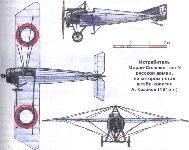 |
А.Шепс - Самолеты Первой мировой войны. Страны Антанты
|
| Истребитель Моран-Солнье тип N русской армии, на котором летал штабс-капитан А.Казаков (1915г.)
|
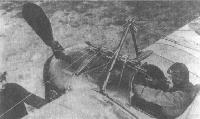 |
А.Шепс - Самолеты Первой мировой войны. Страны Антанты
|
| Отсекатели пуль, установленные на лопастях винта истребителя "Моран". Пулемет "Сент-Этьенн", установленный на Моран-Солнье, имел магазинное заряжание
|
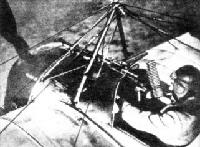 |
В.Кондратьев - Самолеты первой мировой войны
|
| Замена пулеметной обоймы на "Моране-Солнье N".
|
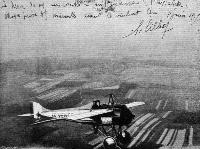 |
Журнал - Flight за 1915 г.
|
| A curious photograph showing M. Gilbert, the well-known French aviator, on his Morane-Saulnier "le Vengeur," taken from another French warplane, on June 17th last, 45 minutes before Gilbert made his attack against one of the enemy's Aviatik machines. Photograph reproduced by courtesy of I'Aerophile.
|
 |
Сайт - Pilots-and-planes /WWW/
|
| Morane-Saulnier Type N Le Vengeur serial MS 388 of pilot Eugene Gilbert
|
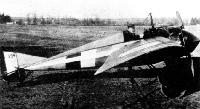 |
В.Кондратьев - Самолеты первой мировой войны
|
| "Моран-Солнье N" из эскадрильи MS.12 французских ВВС, 1915 г.
|
 |
Jane's All The World Aircraft 1919 /Jane's/
|
| A Morane-Saulnier Type N "monoplan de chasse" or "destroyer" - 1914-16 type, with monocoque fuselage. 80 h.p. Gnome or Le Rhone engine, allowing 102 mph.
|
 |
W.Green, G.Swanborough - The Complete Book of Fighters
|
| The shoulder-winged Morane-Saulnier Type N single seater had been completed early in 1914 and was actually in Austria being demonstrated by Roland Garros to the authorities there on 28 June 1914, the day Prince Franz Ferdinand was assassinated and set in train the events quickly leading to war in Europe. Early examples of the Type N that went into French service in 1914 were powered with the 80hp Gnome, as were a small batch delivered to the Imperial Russian Air Service, whereas the final machines delivered to the RFC used the 110hp Le Rhone. Top level speed was 102mph at 6.560 feet, while the aircraft's operational ceiling was 13,125 feet. During the spring of 1915, the Type N, previously used as a fast, unarmed scout, was fitted with the Garros-devised bullet deflecting propeller cuffs and a Hotchkiss machine gun and transformed into a fighter, as with the French machine seen here. Not built in great numbers, the French took only 49 to equip Escadrille MS 23, while the Russians formed one squadron and the RFC took sufficient to partially equip Nos 3 and 60 squadrons.
|
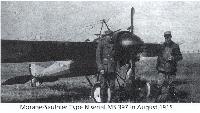 |
Сайт - Pilots-and-planes /WWW/
|
| Morane-Saulnier Type N serial MS 397 in August 1915
|
 |
Журнал - Flight за 1915 г.
|
Captor and Captive. - A German L.V.G. biplane forced to descend by the French aviator, Adjudant N., who was flying the little fast single-seater Morane-Saulnier monoplane seen in the photograph beyond the German machine.
LVG C.II 529/15 downed by Jean Navarre on 20 October 1915. As shown in the magazine photo, Navarre was flying a Morane-Saulnier N fighter at the time.
|
 |
Сайт - Pilots-and-planes /WWW/
|
| Morane-Saulnier Type N, probably at the Morane-Saulnier factory. The airscrew is armored and the aircraft is armed with a single Hotchkiss machine-gun
|
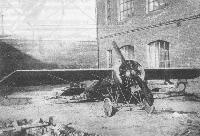 |
В.Кондратьев - Самолеты первой мировой войны
|
| "Моран-Солнье"N, построенный на московском заводе "Дукс"
|
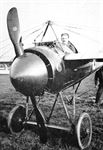 |
A.Weyl - Fokker: The Creative Years /Putnam/
|
| The machine-gun and armoured airscrew of the Morane-Saulnier Type N
|
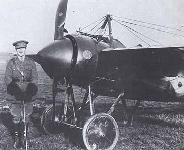 |
В.Шавров - История конструкций самолетов в СССР до 1938 г.
|
|
|
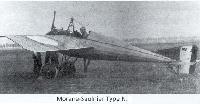 |
Сайт - Pilots-and-planes /WWW/
|
| Morane-Saulnier Type N
|
 |
В.Кондратьев - Самолеты первой мировой войны
|
| "Моран-Солнье I" российских ВВС, осень 1916 г.
|
 |
В.Шавров - История конструкций самолетов в СССР до 1938 г.
|
| "Моран монокок"
|
 |
В.Шавров - История конструкций самолетов в СССР до 1938 г.
|
| Picture shows Russian ace Ivan Smirnov and a captured German officer in front of a Morane-Saulnier Type I of XIX Fighter Detachment. Note faulty retouched right wing tip - the triangular fitment on it is in fact the cabane (king post) structure of a distant Morane-Saulnier Type P parasol.
|
 |
J.Bruce - Nieuport Fighters /Albatros/
|
| Two Nie.11s and a Morane-Saulnier Type N of a Russian fighter squadron.
|
 |
W.Green, G.Swanborough - The Complete Book of Fighters
|
| Essentially a Type N variant, the Type I had a more powerful Le Rhone engine.
|
 |
W.Green, G.Swanborough - The Complete Book of Fighters
|
| No production took place of the fighter version of the Morane-Saulnier Type G.
|
 |
A.Jackson - British Civil Aircraft since 1919 vol.3 /Putnam/
|
| Morane-Saulnier Type N replica
|
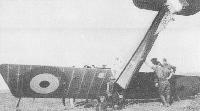 |
W.Green, G.Swanborough - The Complete Book of Fighters
|
| Little success attended the Type V, a dozen examples of which saw brief service with the RFC.
|
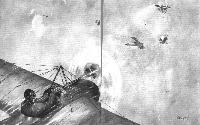 |
Журнал - Flight за 1916 г.
|
| WAR IN THE AIR. - An attack upon a German A.E.G. biplane and an Aviatik. The latter subsequently hit and was brought down. This is but an example of many air fights of almost daily occurence at the Front, this particular incident being one of the "scraps" which Vedrines on his monoplane carried through, when fire machine-gun straight through the propeller field, the propeller being fitted with a deflector for warding off any stray bullets that may not get clear through between the revolving vanes. It is this principle which has been adopted in the Fokker.
|
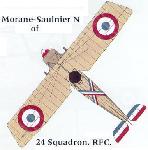 |
Сайт - Pilots-and-planes /WWW/
|
| Morane-Saulnier N of 24 Squadron, RFC
|
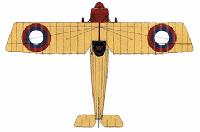 |
Сайт - Pilots-and-planes /WWW/
|
|
|
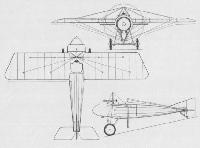 |
W.Green, G.Swanborough - The Complete Book of Fighters
|
| The Type N had propeller-mounted bullet deflectors for its single machine gun.
|
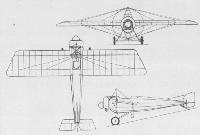 |
W.Green, G.Swanborough - The Complete Book of Fighters
|
| A single gun armed the Type G fighter.
|
 |
В.Шавров - История конструкций самолетов в СССР до 1938 г.
|
|
|
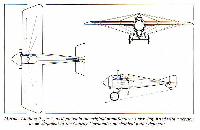 |
В.Шавров - История конструкций самолетов в СССР до 1938 г.
|
|
|
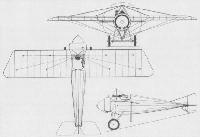 |
W.Green, G.Swanborough - The Complete Book of Fighters
|
| The Morane-Saulnier Type V
|
 |
В.Кондратьев - Самолеты первой мировой войны
|
| Morane Saulnier N
|
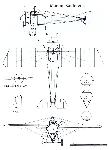 |
Сайт - Pilots-and-planes /WWW/
|
|
|








































